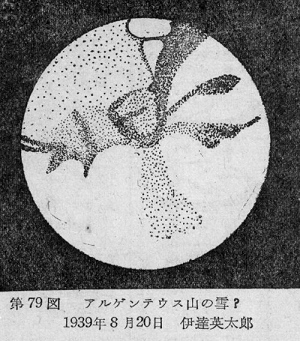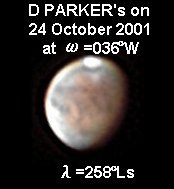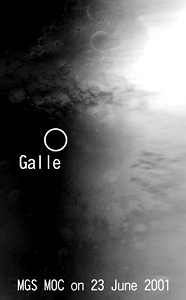

 Here is a copy of the drawing made on 20 August 1939 by Eitaro DATÉ (1912 ~ 1953, Kyoto) who held the position of the first Director of the OAA Mars Section. This was reproduced by the hands of the successor Tsuneo SAHEKI (1916 ~ 1996) based on a postcard sent from DATÉ to SAHEKI (the original postcard was once shown to the present writer) and was included in the first edition of SAHEKI's book published in 1952. The season corresponded to λ=233°Ls and so fell around within the period ANTONIADI pinned down. SAHEKI thus interpreted the white peculiar triangular area as Argenteus Mons adjacent to the spc based on ANTONIADI's description. DATÉ's observation was made when δ=22" and φ=8°S. DATÉ used a Newtonian having a 26 cm speculum put on a German equatorial mounting (at 340x on the day). The drawing does not tell about the relation with Argyre, but we should say this white area looks quite realistic. We here depend on SAHEKI's interpretation.
Here is a copy of the drawing made on 20 August 1939 by Eitaro DATÉ (1912 ~ 1953, Kyoto) who held the position of the first Director of the OAA Mars Section. This was reproduced by the hands of the successor Tsuneo SAHEKI (1916 ~ 1996) based on a postcard sent from DATÉ to SAHEKI (the original postcard was once shown to the present writer) and was included in the first edition of SAHEKI's book published in 1952. The season corresponded to λ=233°Ls and so fell around within the period ANTONIADI pinned down. SAHEKI thus interpreted the white peculiar triangular area as Argenteus Mons adjacent to the spc based on ANTONIADI's description. DATÉ's observation was made when δ=22" and φ=8°S. DATÉ used a Newtonian having a 26 cm speculum put on a German equatorial mounting (at 340x on the day). The drawing does not tell about the relation with Argyre, but we should say this white area looks quite realistic. We here depend on SAHEKI's interpretation.
If we assume the length given by 50°Ls of the temporary period given by ANTONIADI, the existence of Argenteus Mons may be regarded as a milestone of the Martian season, just like the well known detachment of Novus Mons. Here the situation is however different: Mons Argenteus is assumed to be a new advent because of snow fall or frost forming, but Novus Mons is a low-placed fragment originally made inside the spc and then detached. If the snow or frost is formed near the melting spc at the season λ=200 ~ 240°Ls, a special circumstance or mechanism must be supposed: For example with the higher Sun and the air warmed, it must be supposed just like the place could extract exceptionally cold water from the underground having a superficial ice reservoir or something like that.
 We now move on to show an excellent ccd image produced by Don PARKER (DPk) on 24 October 2001. On the day, DPk made four sets of images from ω=023°W to 040°W (cf #253 p3161). The example here is from the ones at ω=036°W, and we should say the white triangular area seen near Argyre is quite reminiscent of the one DATÉ observed in 1939. This white patch is explicit on DPk's following 040°W images. It looks stable on the day and can not be regarded as atmospheric but laid on the surface (seen thru R & G). We should note however the season in DPk's case is at λ=258°Ls, and quite deviates from the Antoniadi period. The white patch might have been already seen on Teru KUMAMORI (Km)'s image on 26 September 2001 ( λ=241°Ls) at ω=058°W (#252 p3148), while it was also inspected on his later image on 31 October 2001( λ=263°Ls) at ω=074°W. The images of Maurice VALIMBERTI (MVl) on 3 November 2001 ( λ=265°Ls) at ω=059°W also show it. Mn's drawings on 4 Nov 2001 ( λ=265°Ls) at ω=048°W & 058°W prove also the existence.
We now move on to show an excellent ccd image produced by Don PARKER (DPk) on 24 October 2001. On the day, DPk made four sets of images from ω=023°W to 040°W (cf #253 p3161). The example here is from the ones at ω=036°W, and we should say the white triangular area seen near Argyre is quite reminiscent of the one DATÉ observed in 1939. This white patch is explicit on DPk's following 040°W images. It looks stable on the day and can not be regarded as atmospheric but laid on the surface (seen thru R & G). We should note however the season in DPk's case is at λ=258°Ls, and quite deviates from the Antoniadi period. The white patch might have been already seen on Teru KUMAMORI (Km)'s image on 26 September 2001 ( λ=241°Ls) at ω=058°W (#252 p3148), while it was also inspected on his later image on 31 October 2001( λ=263°Ls) at ω=074°W. The images of Maurice VALIMBERTI (MVl) on 3 November 2001 ( λ=265°Ls) at ω=059°W also show it. Mn's drawings on 4 Nov 2001 ( λ=265°Ls) at ω=048°W & 058°W prove also the existence.
Since, as we recall again here, ANTONIADI did not show Argenteus Mons pictorially in a full detail, we cannot understand how it varied even temporarily (or we don't know how much he observed it during the period). One of his drawings on 23 August 1924 may show it but it's from a different angle, and the one on 18 September 1924 may also show a remnant but it was outside the season he pinned down.
We shall so here follow SAHEKI, and would like to newly define the temporary Argenteus Mons as the white wedge depicted on DATÉ's drawing as well as on DPk's timely images. In this case Argenteus Mons occupies the area of Argyre (or Argyre Planitia). Since at around λ=200°Ls, the spc expands down to 60°S, and so any area around 70°S should be inside the spc. Even at λ=240°Ls the snow line of the spc is around 70°S, and hence we should judge Mons Argenteus on DATÉ's drawing expands down to 50°S, of course occupying an area of Argyre. As to DPk's Argenteus Mons, our colleague NISHITA (Ns) tried to overlay a grid on DPk's image and found that the white spike went down nearly to 45°S or more northward. Note Argyre Planitia is from 45°S upto southward.
Even if we regard this patch in 2001 as the same with the one observed by DATÉ in 1939, we may not easily regard the retardation of the appearance of Argenteus Mons was due to the occurrence of the dust storm in 2001, because of lack of data after ANTONIADI.
In 1924, the dust cloud was observed, but not in 1939. The 1971 was the year the great dust cloud appeared, but no particular one in 1969, and 1986 and 1988. In 1924, ANTONIADI describes that already on 10 August 1924 at λ=236°Ls (during the Antoniadi period) the surface was covered by a yellow cloud to the extent it showed a crème colour just like the planet Jupiter.
We therefore try to look for Argenteus Mons in 1969 and 1971 in Shotaro MIYAMOTO's observations, and the cases in 1986 and 1988 from Mn's observations in Taipei:
As to the 1969 aspect: MIYAMOTO made a drawing on 13 Aug 1969 ( λ=207°Ls) at ω=040°W, but the area was not distinct. On 15 Aug 1969 ( λ=209°Ls) at ω=029°W, a small white patch in Argyre, but φ=9°N. On 18 Sept 1969 ( λ=230°Ls) the area was obscure, and even Argyre was not distinct. On 24 Oct 1969 ( λ=252°Ls) just the spc was bright. Already δ=8.1". Thus there is no explicit trace of Mons Argenteus in MIYAMOTO's drawings in 1969.
In 1971, MIYAMOTO produced good drawing on 28 July 1971 at λ=223°Ls when δ=23.8", but there was no patch related with the spc while Argyre showed a complex figure. Similarly on 30 July. On 27 Aug 1971 at λ=243°Ls Argyre became deformed without Mons Argenteus. On 4 Sept 1971 at λ=247°Ls the angle was seen but nothing about Mons. The next occasion was lost because of the occurrence of the dust storm.
In 1986 and 1988, the present writer (Mn) observed Mars at Taipei, Taiwan (located at 25°N): Argyre was seen in a triangular form adjacent to the spc from 28 May 1986 at λ=178°Ls to 3 June 1986 at λ=182°Ls. Not so light, but Mn suspected slightly snowed or frosty at Argyre. φ=10°S (see below a drawing on 2 June 1986). The area appeared next from 4 July 1986 at λ=200°Ls, but Argyre was not distinct. The condition on 7 July was good, but without any hint of Mons Argenteus. δ=22.7" and φ=6°S. Another opportunity within the Antoniadi period came in mid-August, but the observation on 13 Aug 1986 ( λ=224°Ls) at ω=046°W just showed the triangular Argyre, but not light while the portion of the spc adjacent to Argyre was very bright. The same results on 14 Aug, 15 Aug and 16 Aug 1986 at λ=226°Ls. At this time the northern polar district to Chryse was quite hazy mixed with the dust particles. During the period from 14 Sept 1986 ( λ=244°Ls) to 21 Sept 1986 ( λ=248°Ls) Argyre was seen with the smaller spc, but just light. On 21 Oct 1986 ( λ=267°Ls) at ω=051°W, the triangular Argyre was seen but not particularly Mons Argenteus.
In 1988 the observation on 20 July 1988 at λ=237°Ls was made inside the Antoniadi period: Argyre was near the CM and looked rather round showing a dusty surface. The region was observable at Taipei until 23 July at λ=239°Ls, with δ=15.9", φ=22°S, but nothing was identified with Mons Argenteus. Argyre at the CM visited next around on 24 August 1988 ( λ=259°Ls): On 25 August we had a good seeing, while Argyre looked just complex without Mons Argenteus. Notable however was the fact that the spc appeared split into two parts those days. δ=21.2" and φ=20°S. If we compare this with the famous drawing of ANTONIADI on 18 September 1924 ( λ=261°Ls), the latter shows a small detached patch from the spc, and this may be a remnant of Argenteus Mons he defined. If this is so, this side of the split spc seen in 1988 might be related with the small detachment in 1924. However the season λ=261°Ls was outside of the Antoniadi period.
We just referred to no more than the observations made from the Oriental side just on the assumption that if Mons Argenteus appeared it should have stay there more than one (terrestrial) month. If it is shorter-lived, we must look for the observations made from different foreign angles.
Our concern was originally with the effect of the dust cloud on the seasonal appearance of Argenteus Mons, but as shown above the presence of Mons Argenteus has not been definite even when the dust cloud was utterly absent. It is obvious there is an enormous lack of later data, and so we must need further observations on the area around at the Antoniadi period.

